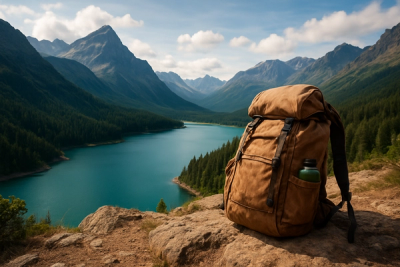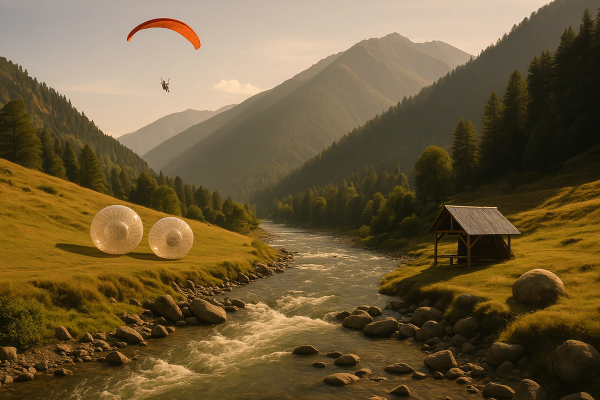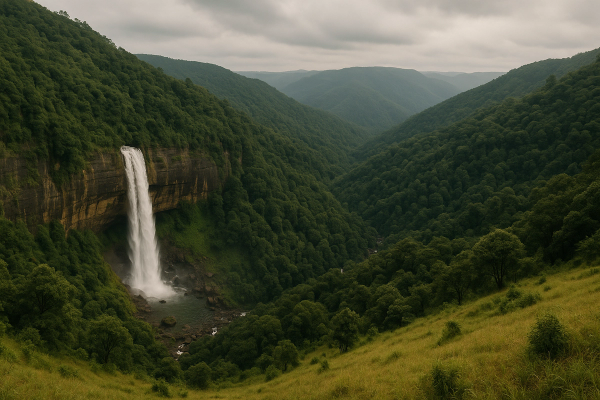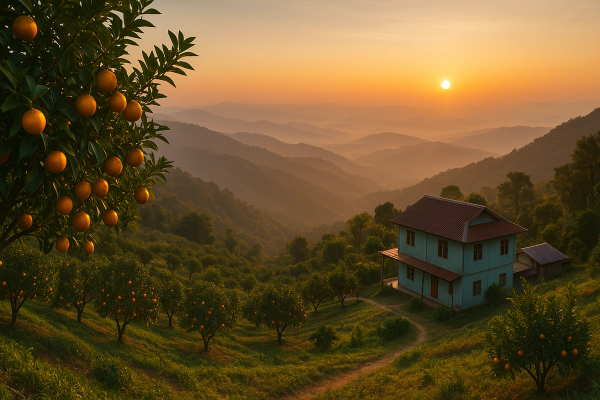Unmissable Indian Winter Treks 2025: Himalayas & Ghats — the messy, magical truth from the trail#
So, um, I finally did it. I spent the winter of 2024-25 bouncing between the Himalayan snow and the mossy-green Western Ghats, and honestly, I’m still picking pine needles out of my backpack. If you’ve been eyeing January or February for a big India trek in 2025, this is me telling you it’s totally doable, totally epic, and occasionally, totally freezing. I’ve got a few hot takes, some very cold nights, and a bunch of practical stuff that’s actually updated for 2025—permits, visas, pricing, train realities, the whole messy kit.¶
Why winter, why now#
I used to avoid cold like my cat avoids bathtime, but winter treks here hit different. Clear skies. No leeches (Ghats trekkers, you know). Fewer crowds if you plan right, though not zero. Plus 2025 travel vibes in India are a sort of cool mix of micro-groups and homestays—lots of folks ditching massive operators for smaller local partnerships, which I loved because you end up sitting by the kitchen fire eating rotis with your guide’s auntie.¶
- Snow lines are cleaner in Jan–Feb up north, views of 8,000ers are stupidly crisp
- Western Ghats in winter = golden-grass ridgelines, cool mornings, almost no rain
- UPI payments everywhere in 2025 (even chai stalls), but carry some cash up high
- Permit systems got stricter in some places—don’t wing it like me, pls
Himalayan winter treks I actually hiked (and one I skipped… on purpose)#
Kedarkantha, Uttarakhand — yes it’s popular, yes it’s still worth it#
I went up from Sankri (Dehradun > Purola > Sankri, that bus ride is chaos but kinda fun) in early January. Juda Ka Talab was frozen like an old mirror. Sunrise on summit day—pink light on the peaks, my fingers numb because I underestimated wind. Classic. 2025 note: the Uttarakhand forest checkposts around Sankri are more organized now—mandatory registration and daily camping quotas get enforced, especially around Juda and Kedar Kharak. A decent local operator charges roughly ₹7,500–₹12,000 for the 4-day trek including permits, tents, food. Homestays in Sankri have gone up a bit—₹1,200–₹2,000 per night for a warm room, basic. I met a group who tried to show up without booking; they got pushed a day because of cap limits. Don’t be them. Summit views? Swargarohini will steal your breath and your remaining battery.¶
Brahmatal & Bekaltal — the quiet sister (sort of)#
I did Brahmatal after Kedarkantha and honestly liked it more. The forest sections are dreamy, and when snow dusts the oaks you’ll feel like you walked into a black-and-white film. On a clear day you get views of Trishul and Nanda Ghunti that look fake. If you’re picking between the two in 2025, Brahmatal seemed a tad less crowded, but the camps are tighter regulated now—same story: forest permits, daily quotas. Prices similar to Kedar. Loha Jang base village stays ran about ₹1,500–₹2,500. Carry microspikes if you own them; I slipped near Bekaltal and did that cartoon flail dance—no one saw (I hope).¶
Kuari Pass (Curzon Trail) — old-school views, modern headaches#
This one is nostalgic and pretty darn scenic—Nanda Devi feels so close it’s like she’s watching. I joined a smaller group (5 of us) and it felt right with the 2025 trend—micro groups = less noise, kinder on trails. Permits are a moving target depending on which approach you take (Dhak > Gulling > Khulara for us). Weather in Jan can slam you with wind; layer like your life depends on it because sometimes it does. Budget? Similar ballpark: ₹8k–₹13k for multi-day if you go with a local crew, homestays in Joshimath around ₹1,800–₹3,500 now. Network was spotty; download offline maps, don’t be me relying on bars that vanish when you need them.¶
Prashar Lake, Himachal — snow donut around a floating island temple#
Quick hit from Mandi side, and in Jan the lake can do this gorgeous half-freeze thing with snow frosting the meadows. My best moment: tea with a shepherd who told me about summers up at the high pastures—he had this laugh like he knew all the mountain jokes. Camping is more regulated (no wild tents near the temple zone). Guesthouses near Prashar were ₹1,000–₹2,000. If roads ice up, local taxis will quote whatever they feel like; bargain gently and accept that winter rates add a "risk tax."¶
Ladakh in winter — skip Chadar (sorry) and do homestay treks#
Okay, this is spicy: I didn’t do Chadar. A lot of operators push it, but freezing patterns on the Zanskar have been unreliable in recent years and, as of 2025, Ladakh authorities have been on-and-off about safety advisories. Also, road work in the region keeps messing with logistics. If you’re dreaming of Ladakh snow, look at shorter homestay treks near Sham Valley or around Likir–Alchi. The Atal Tunnel means Lahaul gets winter access now, and Sissu is a legit base for snow walks—no formal permits for the tunnel itself, but standard ID checks. Foreigners still need permits for certain Ladakh areas (Nubra, Pangong variants), and those can be done online via LAHDC systems when they’re up—just check before you go. Costs? Homestays ₹1,500–₹3,000 with meals; guided day treks ₹2,000–₹4,000. Also: altitude is not playing—take it slow, you don’t want to meet AMS at -15°C.¶
Western Ghats winter treks — crunchy grass, cloud-seas, coffee smell everywhere#
Kudremukh, Karnataka — rolling ridges, strict entry caps#
I went in mid-December. The trail’s a golden ribbon over green hills, with those slow switchbacks that make you feel like you’re in a Studio Ghibli scene. 2025 reality: permits are capped per day and you’ll need to get them through the forest department gate (Kudremukh NP). No camping allowed in the core area. Guides are mandatory, and they’re good company anyway. Costs have crept: entry fees + guide around ₹600–₹1,000 per person depending on group size; homestays in the belt run ₹1,500–₹2,500. Wear proper trail shoes—the last creek crossing before the climb got me soaking wet because I thought I was nimble. I was not.¶
Kumara Parvatha (Pushpagiri), Karnataka — the Gradually Crushes Your Ego trek#
Hiked from Subrahmanya side, camped near the forest checkpost zone (no camping at the summit, still a rule). This trek will test your patience—steep forest sections, sudden viewpoints, and then more steep forest. Worth it. Fees and checkpoints felt tighter in 2025, which I appreciated—less litter. If you’re fit and stubborn, it’s spectacular. I paid around ₹500–₹800 total in checkpost/guide bits, plus a simple lodge near Kukke at ₹1,200. Pro tip: start early, the heat on the descent is like walking through soup.¶
Tadiandamol, Coorg — beginner friendly, still a mood#
Easy-ish gradient, pretty ridgelines, and a nice payoff at the top. Permissions are sometimes required depending on which trailhead you use; we registered at the base and went up without issues. Camping rules vary (and often lean towards no); 2025 is definitely stricter about fires. Coorg homestays are a vibe—coffee estates host you for ₹2,000–₹3,500, breakfast included, and they’ll pack you lemon rice for the trail if you smile nicely.¶
Chembra Peak, Kerala — heart-shaped lake hype, still gorgeous#
You get permits at Meppadi, daily entry limits enforced, and no camping near the famous heart lake. We had a ranger lecture (sweet guy) about keeping the place clean. Entry + guide ran about ₹900–₹1,200 for two of us. Winter is perfect—clear and cool. I always think Kerala forests smell different, like richer somehow. We ate parottas after and I slept like a rock.¶
2025 logistics that actually matter (visa, permits, trains, phones)#
Visas first: India’s e-Tourist visa is alive and well for most eligible nationalities in 2025—30-day double-entry, 1-year multiple, and 5-year multiple are the common buckets. Apply only via the official government site; don’t touch third-party weirdos that overcharge. Have 6 months passport validity and a printed copy of your e-visa when you land (immigration likes paper). No COVID test requirements now, but if you’re coming from yellow-fever countries you may need that certificate. Some zones still need extra permits: foreigners need Restricted/Protected Area Permits for certain areas (parts of Sikkim, Arunachal, Nagaland; Ladakh sectors like Nubra/Pangong). Uttarakhand and Himachal forests have beefed up digital/onsite registrations for trekking in 2025—don’t bank on bribing your way through, it’s mostly gone.¶
- UPI is everywhere, but signal isn’t—download offline maps, carry ₹3k–₹5k cash up high
- Indian trains are still the cheapest way to move—book via IRCTC; Tatkal works but is stressful
- Night buses are okay-ish, but buy the front seats if you get motion sick (me and him did, oops)
What it cost me in 2025 (rough, but real)#
My winter budget per day in the hills hovered around ₹2,000–₹4,000 without a guided trek, and ₹7,500–₹12,000 for 3–5 day guided Himalayan treks (permits, food, tents included). Hostels in Rishikesh/Manali at ₹600–₹1,500 for a bunk; homestays ₹1,200–₹3,500 for a room and hearty meals. Gear rental—crampons/microspikes ₹300–₹500 per day, down jacket ₹200–₹400 per day. Western Ghats day treks are cheaper: entry + guide typically ₹300–₹1,000 depending where. Flights into Dehradun/Bagdogra/Benagluru swing seasonally, but I paid ₹4,000–₹9,000 one-way on domestic routes by booking 2–3 weeks out in December. Travel insurance is boring, yes, but please get it—heli-rescues are not cheap and winter weather can turn fast.¶
Safety stuff in 2025 I wish someone yelled at me about#
Weather’s been funky—clear spells are dreamy, but storms roll in faster than rumors. Daily trek quotas, camping bans (Triund overnight camping still a no, btw), and stricter permit checks mean you gotta plan. Atal Tunnel keeps Lahaul open year-round but black ice isn’t your friend. Keep snacks and a tiny powerbank in your inner pocket so they don’t freeze and die. Also: don’t be that person blasting music on the trail. The langurs judge you and so do I.¶
What I actually did vs. what I totally missed#
I did Kedarkantha, Brahmatal, Kuari, Prashar, Kudremukh, Kumara Parvatha, Tadiandamol, Chembra. I skipped Chadar because the freeze window looked iffy and permits info was all over the place in January. I wish I’d slotted Goecha La (Sikkim) but foreigner permits and winter access are trickier—check Khangchendzonga NP rules for 2025 if you go. Also wanted to do Sandakphu–Phalut in snow (tea-house trek, views of Everest and Kanchenjunga), but the timing didn’t line up. Next winter, for sure.¶
Mistakes I made (learn from my chaos)#
- Forgot gaiters. Ended up with snow in shoes. Unpleasant.
- Didn’t pre-book permits for one trek—lost a day waiting, ate too many Maggi noodles.
- Underestimated wind-chill. My -5°C bag was… optimistic. Bring a liner.
- Trusted Google for bus timing once. Ask locals; they know the real schedule.
Food things you should absolutely do#
Drink butter tea in the cold—love it or hate it, it works. In Uttarakhand, eat Garhwali thali at a homestay: mandua rotis, pahadi rajma. In Himachal, siddu with ghee is a hug. Western Ghats—Coorg’s pandi curry is a legend, and I got addicted to neer dosa with coconut chutney after Tadiandamol. Trail snacks: chikki, oranges, and those warm boiled eggs you buy from a bus-stop auntie who somehow makes them taste like childhood.¶
Somewhere between a frozen lake and a hot chai stall, I remembered why we go—because the world is big, and we need to feel small sometimes.
Where I stayed (and how much I grumbled)#
Sankri homestay—₹1,500 for a room, extra ₹250 for a bucket of hot water and worth every rupee. Joshimath guesthouse—₹2,200, mediocre Wi-Fi, great aloo parathas. Mandi–Prashar belt lodge—₹1,200, thin walls, tons of stars. Coorg coffee-estate homestay—₹3,000, I would marry their breakfast. Bengaluru pre-trek hostel—₹800 in a 6-bed dorm, earplugs mandatory because someone always snores like a truck. Availability in Dec–Feb 2025 was decent midweeks; weekends got busy at popular bases, so book 3–7 days ahead if you can.¶
Final thoughts, messy boots and happy heart#
Winter 2025 in India is the sweet spot for meaningful treks—clear views up north, golden Ghats down south, and better (stricter) rules that keep trails from getting wrecked. Get your e-visa sorted, read up on permits for your specific route, and go with local guides who know the mountain’s moods. Pack layers, carry snacks, be nice to the forest checkpost folks, and don’t forget to look up at the stars. If you want more stories or route breakdowns, I drop stuff like this on AllBlogs.in now and then—see you there, maybe with less frostbite and more chai.¶














